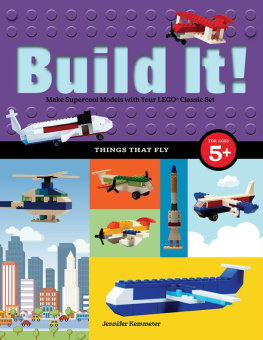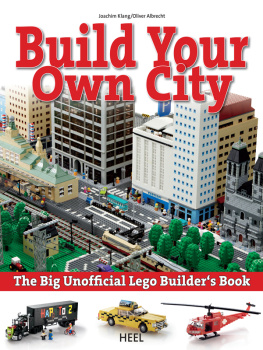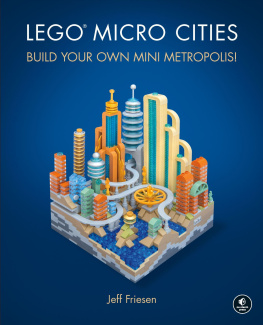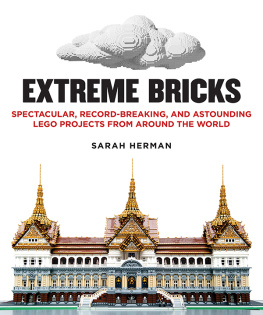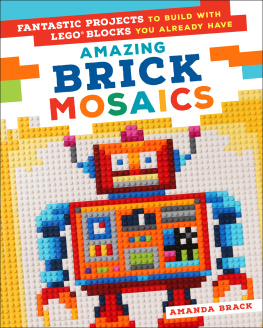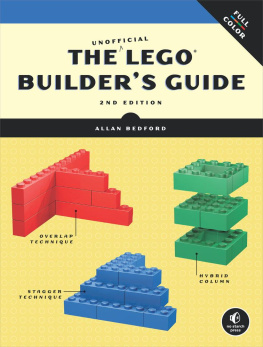HOW TO BUILD
BRICK AIRPLANES
DETAILED LEGO DESIGNS FOR JETS, BOMBERS, AND WARBIRDS
PETER BLACKERT

PREFACE
I n my first book, How To Build Brick Cars, I had the opportunity to share my love of the subject (cars) and my passion for constructing models of them in the medium of LEGO. I confess that I dont design real aircraftthat is a field generally reserved for those who have studied aeronautical engineering. They tend to be clever folks, dealing in magic as much as in science (not reallybut it can feel that way).
Aircraft are nonetheless fascinating, and they marry two dreams: how mankind can make machines, and how to fly as a bird. The magic comes in the marriage of the two, as engineers grappled with their industrial-revolution-age machines and how to get them in the air. There were, for instance, no flying steam locomotives, though the concept of a flying machine drawn in 1850 might have adopted the principle.
Before we ever created a machine, we dreamed of flying. It is a common dream we have as children, along with invisibility and more wishes. Though most flight now occurs in sealed airliners, early aviators (and those who like to hang-glide) probably had the closest experience to that of birds in flight. Exhilarating and risky!
Looking at birds from a structural point of view reveals the ingredients for powered flight. In the hollow bones of birds we see the construction required to give strength and lightness. The shape of birds helps us understand low aerodynamic drag. In birds of prey, we see a serrated trailing edge of their wings and tailthe principles that guide us to some of the stealth technologies. Though they look unusual compared to the aircraft that have gone before, the B-2 Stealth Bomber and the Boeing X-32 prototypes are planes that do not have vertical stabilisers, like birds, but use different mechanisms for controlling the flow of air across the surface of the aircraft for manoeuvring.
I have produced this book in the hope that I can open the window into how machines can be made that can fly. Aircraft are amazing machines, and aeronautics presents itself as one distinct field of engineering and the wider STEM career pathway, one that may be of interest to pursue for younger readers of this book.
The great thing about a second book is that you can fix most of things that needed improving from the first one. Thanks to the team at Motorbooks, we have worked to make improvements to the book, notably in regards to the parts information for the models, which are now in tables, and have clearer images. Some other feedback from the first book that bears repeating here: start at the beginning of the book and work up to the Intermediate and Advanced models. The book is necessarily condensed to encompass this much material, and even experienced builders will find some of the models presented to be extremely challenging.
Something we have tried to add realism to the models is brick printingthe aircraft insignia and nameplates for aircraft stands. Thanks to the team at The Big Brick, we are able to provide this service to those who want to build the aircraft with the printed parts (see ).
I hope that you enjoy building the models in this book, and use them as a basis to try some aircraft design of your own.
Regards,
Peter
WHY BUILD BRICK PLANES?
B rick airplanes: perhaps someone will make one eventually, but house bricks do not make a good building material for aircraft. The bricks here are LEGO, though, and the modelsthough notionally adhering to the design principles of flightdo not fly.
How to Build Brick Airplanes is about creating models of a selection of real aircraft covering more than one hundred years of flight. The earliest plane, the Sopwith Camel, began service in 1917 and was one of the earliest fighting aircraft in WWI. One hundred years later, the Lockheed-Martin F-35B can fly at nearly twice the speed of sound, use stealth technology to approach its target without detection, slow to a hover, and even just about manage a vertical take-off.
The aircraft in this book cover key periods during a century of technological development and achievement. It is perhaps unfortunate that our greatest achievements in flight are often driven by conflicta need for competitive advantage, born of adversity. The SR-71 Blackbird, the fastest plane ever built, capable of flying close to the edge of space, never dropped a bomb. Instead, it was used as a weapon of intelligence, able to fly to any location on earth, equipped with cameras, to spy on the enemy, safe in the knowledge that it could out-speed any missile.
LEGO bricks provide the medium of creation here. The simple models use fewer than 100 parts; the Lockheed P-38 Lightning in the final chapter uses over 2,000. The larger the model, the finer the fidelity of model-making. This is true of all models. A simple model describes simply the principle; the more complex the model, the more detail it reveals. The B-2 Spirit and all models in the Intermediate and Advanced Sections have moving aerodynamic control surfaces; these are also built using modular techniques that represent the assemblies used in real aircraft and describe their function. The Lockheed P-38 Lightning adds LEGO Technic piston engines and gear-driven undercarriage to display still greater detail.
In How to Build Brick Airplanes, the model-making skills applied to aircraft are just an offshoot of the wider STEM toolkit used by engineers to do their job every day. In my work as an automotive engineer for the Ford Motor Company, I used mathematics, mechanics, structures, materials engineering, and importantly, problem solving to create motor vehicles. I have the opportunity as part of Fords commitment to STEM education in schools to lead LEGO Robotics programs, in which this STEM toolkit is shared with young people who may one day follow a career in these areas. How to Build Brick Airplanes is my opportunity to share my interests in the fields of aeronautical engineering and LEGO model creation with a much wider audience.
HOW TO USE THIS BOOK
D esigning LEGO cars and aircraft is a skill set that has taken me a great many years of building to master. In writing this book on aircraft, I have expanded some of the design techniques seen in How to Build Brick Cars, though the instructional methodology follows the same principles through detailed instructions. The book provides material to aid builders, new or experienced alike, with design techniques and solutions that they can use to create their own model aircraft.
A new builder may find some of the advanced designs beyond their Lego parts collection, building experience, or comfort zone. It is strongly recommended to start in the Miniplanes section before moving on to the Intermediate and Advanced designs.
For the experienced builder, I hope that the less complex models are nonetheless a rewarding building exercise at a smaller scale, and that the more complex models reveal an advanced world of model building, one that more closely reflects the challenges and rewards of designing and engineering real aircraft for the real world.
The building instructions introduce various symbols and nomenclature progressively through the chapters, allowing for the instruction sets to be condensed in the available pages whilst still maintaining clarity. The following symbols and typography are there to aid the builder in selecting the correct parts at each building stage, preparing intermediate assemblies, and connecting to the base model architecture.



